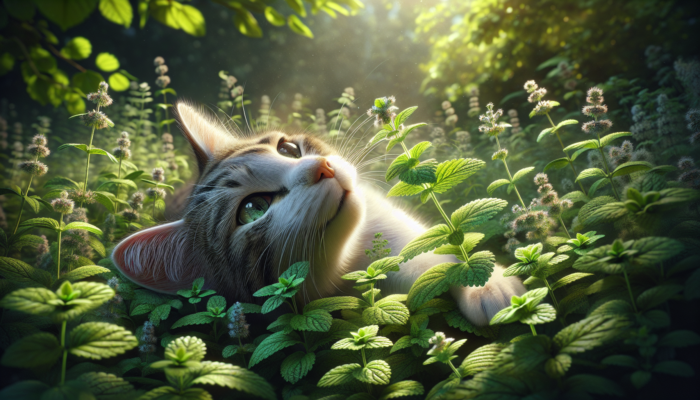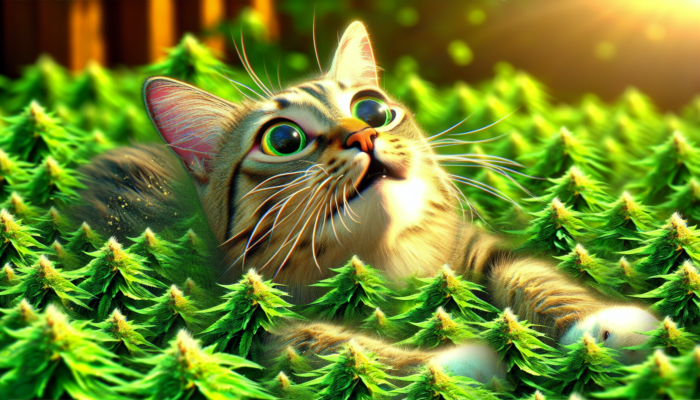Unveiling the Fascinating Effects of Catnip on Cat Behaviour
What is Catnip? Discovering the Herb and Its Powerful Compound

Catnip, scientifically known as Nepeta cataria, is an intriguing herb belonging to the mint family, renowned for its extraordinary capacity to provoke captivating reactions in various cats. This enthralling response is primarily attributed to its active compound, nepetalactone, located in the leaves, stems, and seeds of the plant. When nepetalactone interacts with the olfactory receptors within a cat's nose, it ignites a powerful and diverse array of responses, which can vary significantly from one feline to another, creating a unique experience for each individual.
As cats interact with catnip through behaviours like sniffing, chewing, or rolling in it, they display actions that are both entertaining and perplexing to their human companions. These behaviours may include vocalizations such as purring and meowing, playful rolling around, and numerous other exciting antics. The effects of catnip can last from a few minutes up to about 30 minutes, after which the interest in the herb may temporarily wane. Notably, not every cat will respond to catnip; sensitivity to this herb is hereditary, with studies suggesting that approximately 50-70% of felines react positively to this delightful plant.
The impact of nepetalactone goes beyond simple amusement; it also contributes to improving the overall health and well-being of cats. The euphoric sensations induced by catnip can stimulate playfulness and exploration, essential for sustaining a cat's mental and physical vitality. For those cat owners seeking to enhance their feline friends’ lives, comprehending what catnip is and how its active ingredient operates is crucial for harnessing its full advantages.
Exploring the Neuroscience Behind Catnip’s Fascination
The captivating effects of catnip can be traced back to its profound influence on a cat's neurological system. When nepetalactone is inhaled, it travels directly to the brain, stimulating neurons that govern behaviour. This activation sparks a release of chemicals, particularly dopamine, which plays a significant role in the brain's reward system. The resultant release of these pleasurable hormones leads to the euphoric and, at times, hyperactive behaviours that many cat owners frequently observe in their pets.
While the immediate effects of catnip are undeniably captivating, the long-term implications on a cat’s behaviour and mental health merit equal consideration. Consistent exposure to catnip can invigorate a cat's natural instincts, promoting hunting behaviours and encouraging physical activity. This is particularly advantageous for indoor cats, who may lack sufficient stimulation otherwise. However, it is vital to monitor the frequency of catnip exposure to prevent overstimulation, which can lead to irritability or even aggression in certain felines.
Current research continues to uncover the complexities of how catnip impacts different felines. Studies indicate that the effects may differ not only among individual cats but also across various breeds. For example, certain breeds such as Siamese and Abyssinians seem to respond more enthusiastically to catnip, while others demonstrate minimal reactions. Ongoing studies aim to delve deeper into the neurological pathways involved and how they contribute to the overall feline experience with this captivating herb.
Understanding the Duration and Frequency of Catnip Responses
Grasping the duration and frequency of a cat’s response to catnip is essential for responsible cat ownership. Typically, the effects of catnip last between 5 to 15 minutes following initial exposure. Once these effects diminish, cats may show a temporary indifference to catnip for approximately 30 minutes to two hours. This natural sensitivity cycle is crucial for maintaining a cat’s interest and ensuring they do not become desensitised to the effects of catnip.
For cat owners, timing and moderation are of utmost importance. Frequent exposure to catnip can reduce its effectiveness, as cats may become accustomed to its effects. It is advisable to limit exposure to once every few days, allowing cats to fully enjoy the stimulating benefits without risking boredom or overstimulation, which could lead to negative behavioural changes.
Observing your cat’s responses to catnip can assist in determining the ideal frequency for your furry companion. Some cats might exhibit heightened enthusiasm, while others may respond more subtly. Customising catnip exposure based on your cat’s individual preferences not only enhances their enjoyment but also enriches their overall well-being, achieving a balance between stimulation and relaxation.
Examining the Effects of Catnip on Cat Behaviour

The Joyful Act of Rolling and Rubbing in Catnip
One of the most entertaining and distinct behaviours demonstrated by cats under the influence of catnip is the act of rolling and rubbing. This behaviour often involves cats enthusiastically rolling on the ground, rubbing their bodies against catnip-infused items, and even purring loudly. But what drives cats to engage in these amusing actions?
Rolling and rubbing are instinctual behaviours that serve multiple purposes. Firstly, these actions enable cats to effectively scent-mark their territory. By rolling in catnip, cats not only indulge in the herb but also leave their unique scent on it, claiming it as part of their environment. This instinctual behaviour is reminiscent of their wild ancestors, who relied on scent for communication and asserting their presence.
Moreover, the act of rolling and rubbing creates a sensory experience that stimulates both physical and mental engagement. This playful behaviour promotes physical exercise, which is essential for maintaining a healthy weight and muscle tone. Additionally, the euphoric sensations triggered by nepetalactone encourage cats to embrace their playful nature, leading to more interactive playtime and bonding opportunities with their human companions.
It is imperative to observe your cat during these joyful moments. While rolling and rubbing are generally harmless behaviours, excessive rolling can sometimes result in skin irritations or injuries, particularly if the surface is rough. Creating a secure environment for your cat to indulge in these behaviours ensures they can fully enjoy the delightful effects of catnip without encountering any adverse outcomes.
Boosting Playfulness with Catnip
Another remarkable effect of catnip on cats is the substantial enhancement in playfulness. When cats contact catnip, their natural instincts are often amplified, resulting in bursts of energy and enthusiasm. This increase in playfulness can manifest in various behaviours, including chasing toys, pouncing, and engaging in mock hunts, all of which are vital for their overall physical and mental health.
The stimulating effects of catnip can transform a lethargic cat into an agile and playful companion. For indoor cats, who may lack the same stimuli as their outdoor counterparts, catnip serves as a valuable tool for encouraging active play. Providing catnip-infused toys can significantly enrich playtime, allowing cats to engage in their natural behaviours that foster exercise and mental stimulation.
It is important to note that an increase in playfulness is not solely about physical activity. Engaging in play also aids in reducing stress levels and elevating a cat’s mood, making it a crucial aspect of feline well-being. For cat owners, incorporating catnip into playtime can strengthen the bond between you and your feline friend. The shared enjoyment of playful antics fosters a more enriched relationship as your cat associates fun and joy with your presence.
However, while the increase in playfulness is generally positive, ensuring a safe environment for your cat to explore is essential. Securing toys and ensuring they are free from small parts that could pose a choking hazard is vital. With the right approach, catnip can be a magical addition to your cat’s playtime routine, enhancing their happiness and overall well-being.
The Calming Effects of Catnip on Anxious Cats

While catnip is often associated with heightened playfulness and excitement, it also possesses potential calming effects for anxious or stressed-out cats. The ability of nepetalactone to evoke feelings of euphoria can translate into relaxation for some cats, offering a soothing effect during stressful situations.
Numerous cat owners have discovered that introducing catnip during periods of anxiety, such as thunderstorms or visits to the veterinarian, can help alleviate their cat’s nervousness. The natural properties of the herb can foster a sense of well-being, making it easier for cats to manage stressful stimuli. This duality—acting as both a stimulant and a calming agent—makes catnip a versatile addition to any cat owner’s toolkit.
Beyond immediate calming effects, frequent exposure to catnip can contribute to a more balanced emotional state over time. Cats that regularly engage with catnip may develop heightened resilience to stressors, as the herb helps cultivate positive associations with their environment. This is particularly beneficial in multi-cat households, where competition for resources can lead to stress and tension.
To harness the calming properties of catnip, consider establishing a dedicated space where your cat can enjoy the herb in tranquillity. Whether it’s a cosy nook filled with catnip-infused toys or a scratching post sprinkled with dried catnip, providing a serene environment allows your cat to relax and unwind, enhancing their quality of life.
Practical Uses of Catnip for Your Cat
Effectively Incorporating Catnip into Training Sessions
Integrating catnip into training routines can be an exceptionally effective strategy for reinforcing desired behaviours in your feline companion. The allure of catnip serves as a powerful motivator, transforming training sessions into enjoyable experiences for both you and your cat.
When introducing catnip as a reward, timing is of the essence. It is best to offer it immediately following positive behaviours, so your cat associates the behaviour with the pleasurable experience of catnip. For example, if you aim to train your cat to utilise a scratching post instead of the furniture, sprinkling some catnip onto the post can serve as an enticing lure. This form of positive reinforcement encourages them to engage with the scratching post more frequently.
Moreover, catnip can transform training sessions from mundane tasks into enjoyable games. By incorporating play with catnip into your training routine, you can elevate your cat’s motivation to learn. Utilizing catnip during clicker training or to encourage your cat to perform tricks can enhance their focus and eagerness to participate.
It’s crucial to monitor your cat’s reactions during training sessions involving catnip. Some cats may become overly excited and lose focus, making effective training challenging. Adjust the amount of catnip used based on your cat’s temperament and energy levels to ensure that training remains a positive and productive experience.
Selecting the Perfect Catnip Toys and Accessories
Choosing the right catnip-infused toys and accessories can significantly enhance your cat’s enjoyment and interaction with the herb. The market offers a vast array of options, ranging from plush toys filled with dried catnip to sprayable catnip for your existing toys. Understanding the variety of products available will help you select the best ones for your feline friend.
One popular choice is catnip pillows or stuffed toys, designed for cuddling, rolling, and playful enjoyment. These toys can spark your cat’s curiosity and prompt them to engage in playful behaviours. Look for toys that are well-made and crafted from safe materials, ensuring they can withstand the enthusiastic play that often accompanies catnip enjoyment.
Another excellent option is catnip sprays, which can refresh worn-out toys or even furniture. Spraying catnip onto scratching posts or climbing structures can entice your cat to use them more frequently, redirecting their energy toward more appropriate activities.
When introducing new catnip products, observe your cat’s reactions and preferences. Some cats may favour particular textures or types of toys, while others may show indifference. By tailoring your choices to your cat’s unique tastes, you can maximise their enjoyment of catnip and create a more stimulating environment.
Managing Catnip Use in Multi-Cat Households
Overseeing catnip consumption in multi-cat households can present unique challenges. While some cats may revel in the effects of catnip, others might become territorial or aggressive when competing for access to it. Understanding how to navigate these dynamics is crucial for maintaining harmony among your feline companions.
One effective strategy is to introduce catnip in a controlled manner. Instead of providing a large quantity of catnip all at once, consider offering it to each cat individually, allowing them to enjoy the herb without feeling threatened by their housemates. This approach can minimise competition and create a more positive experience for all cats involved.
Additionally, consider rotating catnip toys or accessories to keep each cat engaged without overwhelming them. By allowing cats to experience catnip at different times, you can ensure that each cat has the opportunity to enjoy the effects without conflict.
It’s essential to monitor your cats’ reactions during these sessions. If one cat tends to dominate the catnip experience, it may be necessary to establish boundaries and ensure that all cats have equal opportunities to enjoy their time with the herb. This approach not only promotes a peaceful environment but also enriches their lives by allowing each cat to experience the delightful effects of catnip without stress or anxiety.
Health and Safety Considerations Regarding Catnip Use in Cats
Assessing the Safety of Catnip for Your Feline Companion
While catnip is generally regarded as safe for most cats, it is essential to recognise that not all cats will respond positively to it. Some cats may experience mild gastrointestinal upset if they consume excessive amounts of catnip, while others may show no adverse effects at all. This variability underscores the importance of moderation when incorporating catnip into your cat’s routine.
Kittens under three to six months old typically do not exhibit sensitivity to catnip, as they have yet to develop the necessary receptors that respond to the herb. Moreover, specific medical conditions or medications may influence a cat’s reaction to catnip. It is advisable to consult with your veterinarian before introducing catnip, particularly for older cats or those with underlying health issues.
Monitoring your cat’s behaviour following exposure to catnip is crucial. Should you observe any signs of distress, such as excessive vocalisations, aggressive behaviour, or vomiting, it may indicate that catnip is unsuitable for your cat. In such instances, discontinuing use and seeking guidance from your veterinarian can help safeguard your cat’s health and well-being.
Recognising the Risks of Overusing Catnip
While catnip can provide enjoyable experiences for felines, overexposure can lead to overstimulation. Signs of overstimulation may include hyperactivity, aggression, or a temporary loss of interest in play. It is vital for cat owners to recognise these signs and adjust the frequency and quantity of catnip provided accordingly.
To prevent overstimulation, it is advisable to limit catnip exposure to once every few days. This interval allows your cat to savour the herb without becoming desensitised to its effects. Furthermore, providing a calm and quiet environment after a catnip session can help your cat regain composure.
If a cat becomes overly excited or aggressive during a catnip session, it may be beneficial to remove the source of catnip and allow them to calm down in a serene space. This approach ensures that your cat can enjoy the stimulating effects of catnip while maintaining a balanced emotional state.
In summary, recognising the signs of overuse and adjusting exposure accordingly is vital for fostering a healthy relationship with catnip. By practising moderation and mindfulness, you can ensure that your cat enjoys the benefits of catnip without potential drawbacks.
Exploring Alternatives to Catnip for Your Feline Friend
While catnip is cherished by many felines, it is essential to consider alternatives for those cats who may not respond to it or require different types of stimulation. Fortunately, several other herbs and plants can evoke comparable reactions in cats, providing exciting new avenues for play and enjoyment.
One popular alternative is silver vine (also known as Actinidia polygama), which has been shown to trigger playful behaviours in cats that do not respond to catnip. Its unique compounds can offer a delightful experience, making it an excellent addition to a cat’s toy collection.
Another option is valerian root, which can produce calming effects in some cats while still promoting playful behaviours. The terpenoids found in valerian root can create a sense of euphoria similar to that of catnip, making it a worthwhile alternative for cats who may not enjoy catnip.
In addition to these herbs, many commercial cat toys now incorporate a mix of various enticing scents, including catnip, silver vine, and valerian root. Experimenting with these alternatives can provide new experiences for your cat, enriching their environment and enhancing their overall well-being.
In conclusion, while catnip is a beloved herb for many cats, exploring alternatives can offer additional stimulation and enjoyment for those who may not respond to traditional catnip products.
Understanding the Influence of Age and Breed on Catnip Reactions
Introducing Kittens to the Wonders of Catnip
A common question among cat owners is when kittens can begin to experience the delightful effects of catnip. Generally, the ability to respond to catnip develops around three to six months of age. Before this age, kittens typically lack the necessary receptors to react to the active compound, nepetalactone.
Introducing catnip to kittens should be approached with caution. It is best to wait until they reach the appropriate age to ensure they can safely enjoy the herb without adverse reactions. Once your kitten reaches the right age, offering small amounts of catnip can encourage playfulness and stimulate their natural hunting instincts.
When introducing catnip to kittens, consider using toys infused with catnip rather than offering it in its raw form. This method allows for controlled exposure and promotes interactive play. Observing your kitten’s reactions can provide valuable insights into their preferences and help you gauge their sensitivity to catnip.
As your kitten grows, catnip can play a significant role in their development. The excitement and stimulation derived from catnip can foster healthy play behaviours, which are crucial for their physical and mental growth. By incorporating catnip into their playtime, you can enhance their overall well-being and cultivate a strong bond between you and your feline friend.
Senior Cats and Their Engagement with Catnip
The effects of catnip can vary significantly in senior cats compared to their younger counterparts. As cats age, their sensitivity to catnip may diminish due to changes in their neurological systems. While some senior cats still respond positively to catnip, others may exhibit little to no interest.
Introducing catnip to senior cats can be beneficial, but it’s crucial to approach it with mindfulness. Offering small amounts of catnip can help stimulate their playfulness and encourage physical activity, which is essential for maintaining their overall health. However, it’s vital to closely monitor their reactions to ensure they do not become overstimulated or anxious.
For senior cats who may not respond to catnip, exploring alternatives such as silver vine or valerian root can provide new avenues for stimulation. These alternatives may elicit playful behaviours in older cats who may have grown indifferent to catnip.
Overall, while senior cats may not experience the same level of excitement from catnip as they did in their younger years, offering it as a tool for enrichment can still positively contribute to their quality of life. Engaging them in gentle play and providing opportunities for stimulation is essential for their happiness and well-being.
Recognising Breed-Specific Variations in Catnip Sensitivity
Interestingly, the response to catnip can also differ among various cat breeds. Research indicates that certain breeds may exhibit heightened or diminished sensitivity to catnip, leading to fascinating behavioural variations. For instance, breeds such as Siamese, Burmese, and Abyssinians are known to demonstrate heightened reactions to catnip, often engaging in lively antics and exhibiting enthusiasm.
Conversely, some breeds, including the Russian Blue and the Scottish Fold, may show little interest in catnip. This variation in sensitivity is largely believed to be hereditary, as the capacity to respond to catnip is linked to genetic factors. For cat owners, understanding their cat’s breed-specific traits can provide valuable insights into their potential reactions to catnip.
For owners of cats less responsive to catnip, it may be beneficial to explore alternatives that can offer similar stimulation. Experimenting with various herbs and toys can help identify what works best for your feline friend. By tailoring your approach to their unique preferences, you can elevate their playtime experience and overall well-being.
In conclusion, recognising the breed-specific variations in catnip sensitivity can aid cat owners in providing optimal experiences for their pets. By understanding your cat’s individual traits and preferences, you can ensure they enjoy the enriching effects of catnip or suitable alternatives.
Clarifying Myths and Misinterpretations About Catnip
Understanding Catnip: Does It Induce a “High” in Cats?
A prevalent myth surrounding catnip is that it induces a “high” in cats, akin to the effects of recreational drugs in humans. However, this misconception misrepresents the true nature of catnip‘s effects on felines. Rather than causing intoxication, catnip stimulates a natural behavioural response that is deeply rooted in a cat’s instincts.
When cats encounter nepetalactone, they experience heightened sensations of playfulness and euphoria, leading to increased activity and excitement. This reaction is purely physiological and does not result in any harmful effects or dependency. Understanding this distinction is crucial for cat owners, as it reassures them of catnip‘s safety and reinforces its role as a beneficial tool for enrichment.
In summary, while catnip elicits a euphoric response in many cats, it is not comparable to the experience of a drug high. Instead, it enhances their natural instincts and encourages playful behaviour, promoting overall well-being without the risks associated with substance use.
The Human Perspective: Can People Use Catnip as Well?
Curiosity often arises regarding whether humans can partake in the effects of catnip. While catnip is primarily known for its impact on cats, it has also been utilized in herbal medicine for humans for centuries. In fact, catnip has traditionally been valued for its calming properties.
Human consumption of catnip is generally safe and can be enjoyed in various forms, such as teas or tinctures. The herb is believed to possess mild sedative effects, potentially aiding in relaxation and sleep. However, it is essential to consult with a healthcare professional before incorporating catnip into your wellness routine, especially if you have underlying health conditions or are taking medications.
While catnip may not elicit the same euphoric experience in humans as it does in cats, its calming properties can be beneficial for those seeking natural remedies for stress or anxiety.
In conclusion, although catnip is primarily associated with feline behaviour, it does offer potential benefits for humans, making it a versatile herb worth exploring.
Dispelling the Myth of Catnip Addiction
Another widespread myth is the belief that cats can become addicted to catnip. This misunderstanding often arises from the intense reactions some felines display when exposed to the herb. However, the reality is quite different: cats do not develop a dependency on catnip in the same manner that humans can become addicted to substances.
The effects of catnip are temporary, lasting for a short duration before cats revert to their baseline state. After experiencing the effects, cats typically lose interest in catnip for a while, demonstrating that their response is not a sign of addiction but rather a natural reaction to the herb.
To ensure your cat enjoys catnip safely, it is essential to practice moderation. Limiting exposure to every few days allows your feline friend to relish the delightful effects without becoming desensitised. By maintaining this balance, you can provide enriching experiences for your cat while avoiding any misconceptions about addiction.
In summary, while cats may exhibit enthusiastic responses to catnip, it is crucial to understand that their reactions do not indicate addiction. Instead, they reflect their natural instincts and enjoyment of the herb, making it a safe and beneficial addition to their routine when used responsibly.
Enriching Your Cat’s Life Through Catnip
Creating Your Own Catnip Garden for Enhanced Enrichment
For cat owners looking to enrich their feline companions’ lives, cultivating a catnip garden can be a delightful and rewarding endeavour. Not only does growing your own catnip provide an endless supply of the herb, but it also offers an engaging way for your cat to explore and interact with their environment.
When establishing a catnip garden, select a sunny spot with well-draining soil. Catnip is a resilient perennial that flourishes in diverse conditions, making it an excellent choice for most gardeners. Planting seeds or seedlings is straightforward, and with proper care, you’ll soon have an abundance of catnip for your feline friend to enjoy.
Encouraging your cat to explore the garden can also provide mental stimulation. Allowing them to sniff, nibble, and play in the garden promotes natural behaviours and enhances their overall well-being. Just ensure that any other plants in the garden are safe for cats, as some common garden plants can be toxic.
Regularly harvesting and drying your homegrown catnip enables you to create toys and treats for your cat, enriching their playtime experience. This hands-on approach not only enriches your cat‘s life but also strengthens the bond between you and your feline companion, making it a fulfilling endeavour for both.
Crafting Custom DIY Catnip Toys for Your Feline
Creating your own catnip toys can be a fun and fulfilling activity that allows you to personalise playtime for your feline friend. Making DIY catnip toys is not only cost-effective but also provides a unique opportunity to tailor the toys to your cat’s individual preferences.
Simple projects, such as sewing small fabric pouches filled with dried catnip, can yield engaging toys that your cat will adore. Alternatively, you can repurpose old socks or fabric scraps by filling them with catnip and securely tying them off. This approach not only gives your cat a new toy to enjoy but also contributes to reducing waste.
Incorporating various textures and shapes into your DIY toys can elevate your cat’s sensory experience. For example, utilising crinkly materials or dangling strings can add an extra layer of excitement, encouraging your cat to engage in playful behaviours. Regularly rotating the toys can help maintain your cat’s interest and ensure they remain engaged and stimulated.
By crafting your own catnip toys, you can create a tailored play experience for your cat, enhancing their enjoyment and overall well-being. This hands-on approach allows you to bond with your feline friend while providing them with engaging, interactive play.
Utilising Catnip to Strengthen Your Bond with Your Feline Companion
Incorporating catnip as a bonding tool with your feline companion can significantly enhance your relationship and create positive shared experiences. The playful and stimulating effects of catnip offer an excellent opportunity for interactive play, fostering a deeper connection between you and your cat.
Engaging in playtime with catnip-infused toys not only provides entertainment but also encourages trust and communication. When you participate in your cat’s play, they learn to associate you with enjoyable experiences, strengthening your bond. This shared time is crucial for building a strong relationship, as it allows your cat to feel secure and cherished.
Moreover, incorporating catnip into training sessions can further enrich your bond. Rewarding your cat with catnip for positive behaviours cultivates a sense of teamwork and cooperation, reinforcing the idea that you are working together towards a common goal. This dynamic can lead to a more harmonious living environment and a happier, more confident feline.
In summary, using catnip to foster bonding and interaction is a wonderful way to enhance your cat’s life. By creating positive experiences through play and training, you can cultivate a deep and lasting relationship with your feline friend.
Addressing Common Inquiries About Catnip and Its Effects on Cats
What is the Most Effective Method to Introduce Catnip to My Cat?
Introduce catnip gradually by offering a small amount in a toy or scratching post. Observe your cat’s reaction and adjust exposure based on their comfort level, ensuring a positive experience.
Can Catnip Assist in Managing Behavioural Issues in Cats?
Yes, catnip can potentially aid with behavioural issues by promoting playfulness and reducing anxiety. However, it’s essential to monitor your cat’s reactions and consult a veterinarian for persistent concerns.
Where Can I Acquire Quality Catnip for My Cat?
Seek high-quality, organic catnip from reputable pet stores or online retailers. Ensure it is free from additives or chemicals to provide the safest experience for your cat.
Is Catnip Safe for Kittens?
Kittens typically do not respond to catnip until they are around 3-6 months old. Once they reach that age, introducing small amounts can be safe and enjoyable for them.
Do All Cats Appreciate Catnip?
Not all cats respond to catnip; sensitivity is genetic. Approximately 50-70% of cats exhibit reactions, while others may show little to no interest.
How Often Can I Offer Catnip to My Cat?
It is advisable to limit catnip exposure to every few days to prevent desensitisation and ensure your cat continues to enjoy its effects.
Is Catnip Harmful to My Cat?
Generally, catnip is safe for cats. However, overconsumption may lead to mild gastrointestinal upset. Moderation is key to ensuring your cat’s well-being.
Can Catnip Help Calm My Anxious Cat?
Yes, catnip can have calming effects for some cats, particularly when used in stressful situations, promoting relaxation and reducing anxiety.
What Are Some Alternatives to Catnip?
Alternatives to catnip include silver vine and valerian root, which can elicit similar playful reactions in cats who do not respond to catnip.
How Long Do the Effects of Catnip Last?
The effects of catnip typically last between 5 to 15 minutes, after which cats may lose interest temporarily, often for about 30 minutes to two hours.
Connect with us on Facebook for the latest updates!
The Article : Catnip Effects on Cats: A Comprehensive Overview Appeared First On Unity Pets.
The Article Catnip Effects on Cats: Understanding Their Behaviour and Reactions Was Found On https://limitsofstrategy.com


The exploration of catnip’s effects on feline behavior truly opens up a window into the fascinating interplay between species and their environments. It’s remarkable how a simple herb can elicit such vivid and varied responses from our cats, showcasing not only their biological instincts but also perhaps deeper aspects of their personality.
You’ve captured the essence of catnip’s influence beautifully. The way cats respond to it does seem to reflect more than just their immediate instincts; it’s a glimpse into their individual personalities and preferences.
“To dive deeper into the captivating world of feline behavior and the role of catnip, check out this insightful resource that explores these themes further!”
https://awesomeappearances.com/VideoLeap